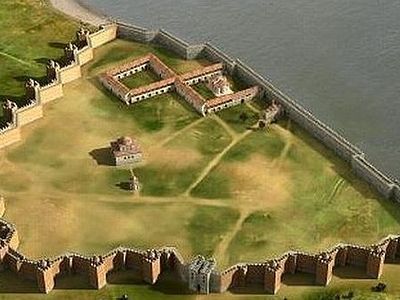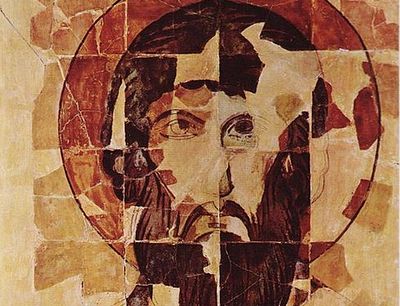Source: Archaeology in Bulgaria
February 10, 2016
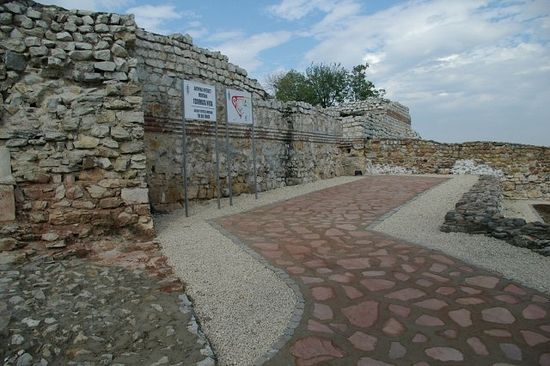 The partly restored ruins of the Ancient Roman city and fortress of Montanesium, today’s Montana in Northwest Bulgaria, which had a major Early Christian basilica right outside its fortress wall. Photo: Montana Regional Museum of History
The partly restored ruins of the Ancient Roman city and fortress of Montanesium, today’s Montana in Northwest Bulgaria, which had a major Early Christian basilica right outside its fortress wall. Photo: Montana Regional Museum of History
The northwestern Bulgarian city of Montana, the modern-day successor of the Ancient Roman city and fortress of Montanesium, is going to excavate and restore partly a 4th century early Christian basilica with Syrian-type architecture as part of a joint cultural project with the town of Pirot in Eastern Serbia.
The project providing for cultural heritage developments in Bulgaria’s Montana and Serbia’s Pirot will be paid for with funding from the EU Trans-Border Cooperation Program, reports the Bulgarian state news agency BTA citing officials from Montana Municipality.
In Bulgaria, the project will finance the further archaeological excavations and partial restoration of the 4th century early Christian basilica and the additional partial restoration of the Castra ad Montanesium Fortress, which was partly restored with EU funding back in 2013, and has already been developed as a cultural tourism site.
The execution of the joint cultural heritage project with Serbia’s Pirot will begin with the renewal of the archaeological excavations of the 4th century basilica of ancient Montanesium in Bulgaria’s Montana in the spring of 2016. Its completion will be due in 2018.
Lead archaeologist Assoc. Prof. Gergana Kabakchieva from the National Institute and Museum of Archaeology in Sofia, who has been working on the research of the Roman city of Montanesium, points out that the basilica in Montana is one of the earliest known Christian basilicas found in Bulgaria (and in Europe, for that matter).
The temple dates back to the first half of the 4thcentury AD, i.e. the period of the reign of Emperor Constantine the Great (r. 306-337 AD), after Christianity was legalized in the Roman Empire with the Edict of Milan in 313 AD.
The basilica of ancient Montanesium was first excavated in the early 1980s by Bulgarian archaeologist Georgi Alexandrov. Kabakchieva resumed the excavations in 2009 and 2010.
The ruins of the early Christian temple are located outside the fortress walls of Montanesium, so that it would allow easier access for the residents of the plain lying to the northeast.
The basilica was 24 meters long, and is estimated to have been between 15 and 18 meters tall.
Its ruins reveal its architecture was modeled after the architectural traditions of the Middle Eastern provinces of the Roman Empire – Syria and Palestine.
In fact, the basilica in Montana is one out of a total of three known Syrian-type early Christian basilicas in today’s Bulgaria, the other two being located on the Black Sea coast: in today’s Black Sea city of Varna (ancient Odessa), and in today’s resort town of Sozopol (ancient Apollonia Pontica), on the St. Ivan Island, where relics of St. John the Baptist were discovered in 2010, and an early Christian tomb was found in 2015 by Prof. Kazimir Popkonstantinov.
The early Christian basilica in Bulgaria’s Montana was a three-nave rectangular temple with a two-story roof, and two side rooms, one for men and one for women. The southern part of the basilica was entirely dug into the rocky hill.
The temple had a large atrium with two entrance passages, from the west and from the north. It could also be directly accessed from the fortress wall of Montanesium via a wooden ladder.
“Our goal is to reveal the ruins of one of the most important early Christian basilicas," lead archaeologist Kabakchieva is quoted as saying, comparing the early importance of the temple in Montana only to two other early Christian basilicas on the Balkan Peninsula found in Thessaloniki, Greece, and Sandanski (ancient Parthicopolis) in Southwest Bulgaria.
Once the renewed archaeological excavations of the basilica in Montana are completed, the walls and staircases of the ancient temple will be partially rebuilt.
Part of the funding will also be used to restore further the Montanesium Fortress, including by installing special lighting.
“This will contribute to the wholesomeness of this historical ensemble as a cultural tourism site, "Kabakchieva says.
Montana is technically the only major city in Bulgaria which still has its Roman name (even though that has changed throughout the ages – learn more in the Background Infonotes below). It has been estimated that during the Roman period, ancient Montanesium had a population of about 30,000.
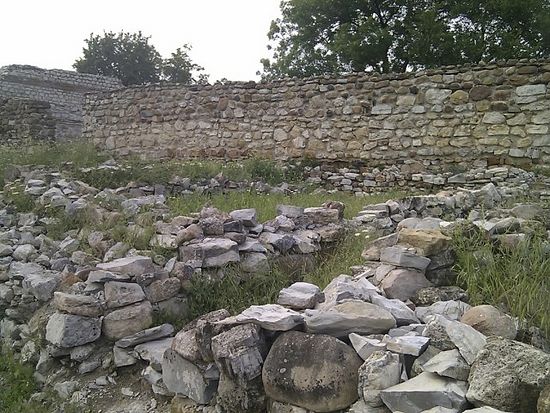 The partly restored ruins of the Ancient Roman city and fortress of Montanesium, today’s Montana in Northwest Bulgaria. Photo: Montana Regional Museum of History
The partly restored ruins of the Ancient Roman city and fortress of Montanesium, today’s Montana in Northwest Bulgaria. Photo: Montana Regional Museum of History
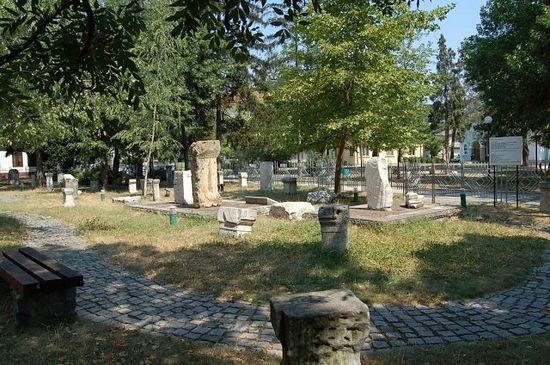 Ancient Roman artifacts exhibited in the open in the yard of the Montana Regional Museum of History. Photo: Montana Regional Museum of History
Ancient Roman artifacts exhibited in the open in the yard of the Montana Regional Museum of History. Photo: Montana Regional Museum of History
Background Infonotes:
The early history of today’s northwestern Bulgarian city of Montana is primarily associated with the Ancient Roman military camp and later city and fortress of Montanesium, initially known as Castra ad Montanesium (“castra" meaning “camp" in Latin) from the Roman Antiquity period (1st-4th century AD). However, the earliest traces of civilized life on the territory of Bulgaria’s Montana date to the Chalcolithic Age (Aeneolithic, Copper Age), from the 5th-4th millennium BC, and have been discovered in the lower archaeological layers on the site of the Montanesium Fortress. During the 1st millennium BC the place was inhabited by the independent Ancient Thracian tribe Triballi, which was allied with the Odrysian Kingdom, the most powerful Ancient Thracian state. From this period, the Montanesium Fortress features preserved sections of the pre-Roman, Ancient Thracian fortress wall, over 1 meter thick, which is located under the Roman fortress’s large fortress tower.
The Roman Empire conquered the region of Montana in today’s Northwest Bulgaria around 29 BC (all of Ancient Thrace south of the Danube was conquered by Ancient Rome in 46 AD) setting up a military camp, Castra ad Montanesium, on top of the existing Ancient Thracian settlement. The archaeological sources about the history of the Roman city of Montanesium come largely from Roman epigraphic monuments. The Romans were interested in the region of Montana because of its ore deposits and the opportunities for mining gold, silver, lead, and iron, especially along the Ogosta River and the Zlatitsa River. The region was one of the major gold mining centers in the Balkan Peninsula in the 1st-3rd century AD. The earliest known Roman military detachment to set up camp at Montanesium in the 1st century AD was Cohors Sugambrorum. The epigraphic monuments indicate the intensified presence of Roman servicemen from Legio I Italica (Italian First Legion) and Legio XI Claudia (Claudius’ 11th Legion) from the first half of the 2nd century AD until the middle of the 3rdcentury AD; Numerus Civium Romanorum was stationed there in the first half of the 3rd century AD, and Cohors III Collecta – in the middle of the 3rd century AD.
The Roman military camp Castra ad Montanesium is mentioned in an inscription from 134 AD; as a result of its development as a settlement, in 160-161 AD, it received the status of a Roman city – municipium – with its own territory (Regio Montanesium) likely corresponding to today’s Bulgarian District of Montana located between the Danube River to the north, and the Balkan Mountains to the south. It was part of the Roman province Moesia Superior where it was the second most important city after the arsenal city on the Danube, Ratiaria (Colonia Ulpia Ratiaria), whose ruins pillaged by modern-day treasure hunters can be found today near Bulgaria’s Archar. In 271 AD, Roman Emperor Aurelian (r. 270-275 AD) transformed the province of Moesia Superior into the province of Dacia Aureliana with its capital at Serdica (today’s Sofia), after vacating Dacia Traiana beyond the Danube. Around 283 AD, Dacia Aureliana was divided into two provinces, Dacia Mediterranea, with its capital at Serdica, and Dacia Ripensis (“Dacia from the banks of the Danube") with its capital at Ratiaria (Colonia Ulpia Ratiaria), and Montanesium as its second most important city. The name of Montanesium is known from several epigraphic monuments from the 2nd-3rd century AD. Its etymology probably stems from the Latin words “mons" (mountain) and “montani" (mountaineers). Specific hypotheses about its origin range from the name of a Roman military detachment called Cohors Montanorum, which was stationed there in the second half of the 1st century AD (whose presence, however, is only indirectly implied in the sources), to the city’s location at the foot of the Balkan Mountains, and to a cult shrine in the pre-Roman settlement.
The Fortress of Montanesium also had a large water spring. It was the site of an ancient rock shrine which was an important cult center during the Roman Age when pilgrims worshipped there a number of Ancient Thracian, Greek, and Roman deities, including Diana and Apollo, who were the city’s Hellenistic Age patrons, as well as Jupiter, Dionysus, Roman god of woods and fields Silvanus, medicine god Asclepius, also known as Aesculapius, and his daughter Hygieia, Thracian supreme god Heros, also known as the Thracian Horseman, Hermes, Heracles (also known as Hercules), Mars, Persian deity Mithra (Mitra), and the spring nymphs. Bulgarian archaeologists excavating the Ancient Roman city of Montanesium have discovered numerous sculptures, votive tablets, and inscriptions left as gifts by a wide range of pilgrims from the military, civilians, aristocrats, and common folk.
Barbarian invasions by the Goths in the middle of the 3rd century AD disrupted the life of the Roman city of Montanesium leading to a reconstruction of its fortress. At the end of the 3rd and the beginning of the 4th century AD, around the time of the reign of Emperor Constantine the Great (r. 306-337 AD), Montanesium flourished together with the numerous Roman villas in its suburbs. The Antiquity shrine and the Roman villas were destroyed at the end of the 4th century AD in a new wave of Gothic invasions. Between 440 and 490 AD today’s Northwest Bulgaria was overrun by the Huns and the Goths; Montanesium waned until the 6th century AD when it was ultimately destroyed by the barbarian invasions of Avars and Slavs (between 500 and 560 AD), like the rest of the Roman cities in today’s Northern Bulgaria. The Slavs who settled there named the city Kutlovitsa which remained its name during the Bulgarian Empire in the Middle Ages. At the time of the Second Bulgarian Empire, in the 12th-14th century AD, Kutlovitsa was the center of a Christian eparchy.


